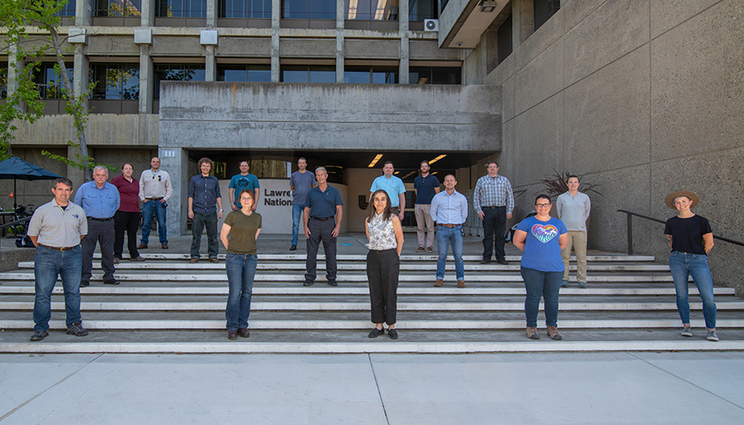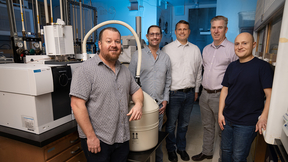LLNL hosts Test Site Verification Team orientation
 (Download Image)
(Download Image)
Members of NNSA’s Test Site Verification Team convened at LLNL recently for orientation. The team is led by Kim Knight from LLNL, second from left in front row, and Emily Schultz-Fellenz from LANL, fourth from left in front row, with senior adviser Stuart Rawlinson from the NNSS, second from left in second row. Also in front row is LLNL Director Kim Budil, middle, and Tim Evans, far left, from ONV at NNSA Headquarters. Walter Dekin of LLNL, on detail to ONV at NNSA Headquarters, is far left second row. Photo by Tom Reason.
Lawrence Livermore National Laboratory (LLNL) hosted an in-person orientation meeting recently for members of the National Nuclear Security Administration’s (NNSA) Test Site Verification Team (TSVT). TSVT is sponsored by NNSA’s Office of Nuclear Verification (ONV) Nuclear Compliance Verification (NCV) Program.
The TSVT is led by Kim Knight from LLNL and Emily Schultz-Fellenz from Los Alamos National Laboratory (LANL) and is supported by Stuart Rawlinson from the Nevada National Security Site (NNSS). The team is comprised of 10 technical experts with backgrounds in nuclear test relevant technologies from LLNL, LANL, Pacific Northwest National Laboratory, Sandia National Laboratories and NNSS.
“The historic experience and present knowledge of nuclear testing at the DOE sites are an essential resource for the team as they prepare to address past, present or future nuclear test activities around the globe,” Knight said.
The ultimate goal of the TSVT is to conduct assessments as part of a transparency or denuclearization agreement related to a country’s underground nuclear explosive testing activities and contribute to an integrated interagency verification evaluation of a country’s nuclear weapons capabilities. Nuclear testing can be a key element of building confidence in a new nuclear weapons program. The TSVT plans to fully begin its multi-year activities in Fiscal Year 2022.
The TSVT provides the U.S. government with field-based support of negotiated treaties and agreements directed at understanding the development of a country’s nuclear testing program and stopping further development and nuclear proliferation. The TSVT’s overarching objectives include verifying a country’s nuclear testing history, confirming cessation of nuclear testing activities and monitoring to ensure no testing takes place in the future. TSVT on-site activities can range from subject matter expert examination of key test site locations to targeted in-field sample and data collection for subsequent analysis.
“The team is building on decades of the nation’s nuclear testing history and nuclear explosion monitoring experience and will maintain readiness to deploy internationally on short notice to provide field-based support of verification of declared or undeclared nuclear testing and associated activities,” Schultz-Fellenz said.
Contact
 Michael Padilla
Michael Padilla
[email protected]
(925) 341-8692
Related Links
National Nuclear Security Administration’sNevada National Security Site
Tags
EngineeringDefense
Threat preparedness
Nonproliferation
Science
Strategic Deterrence
Featured Articles







